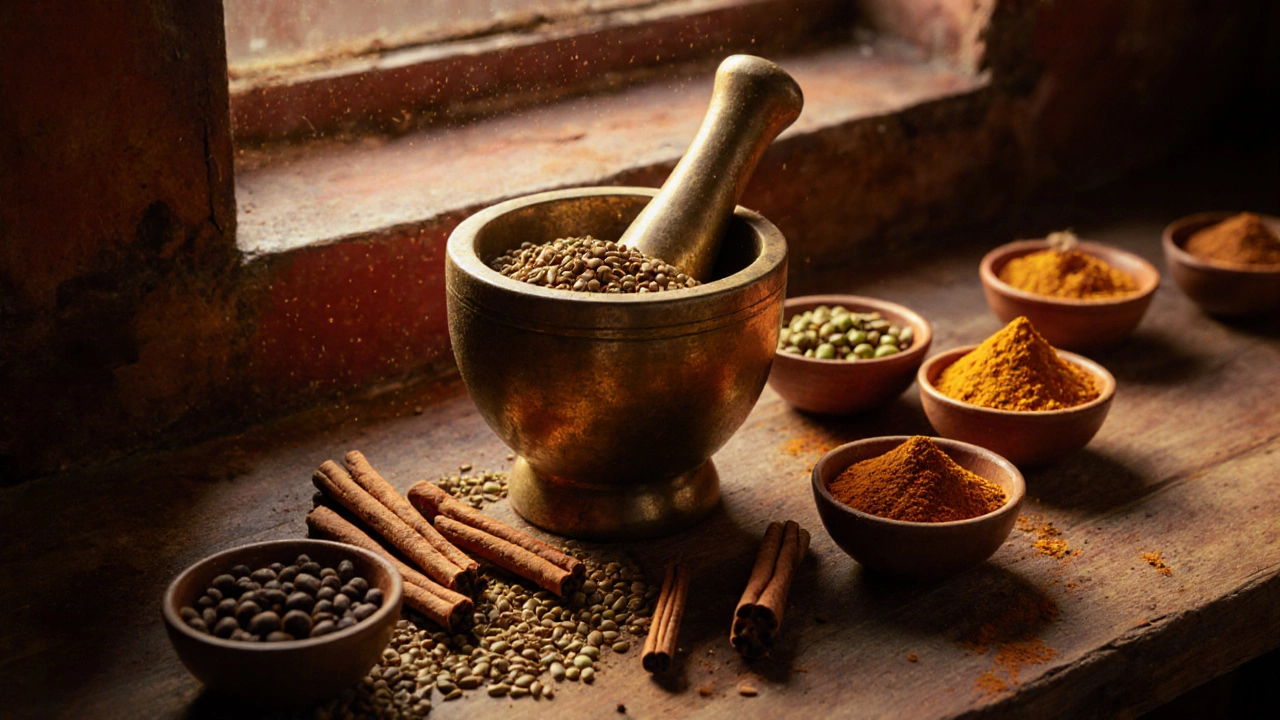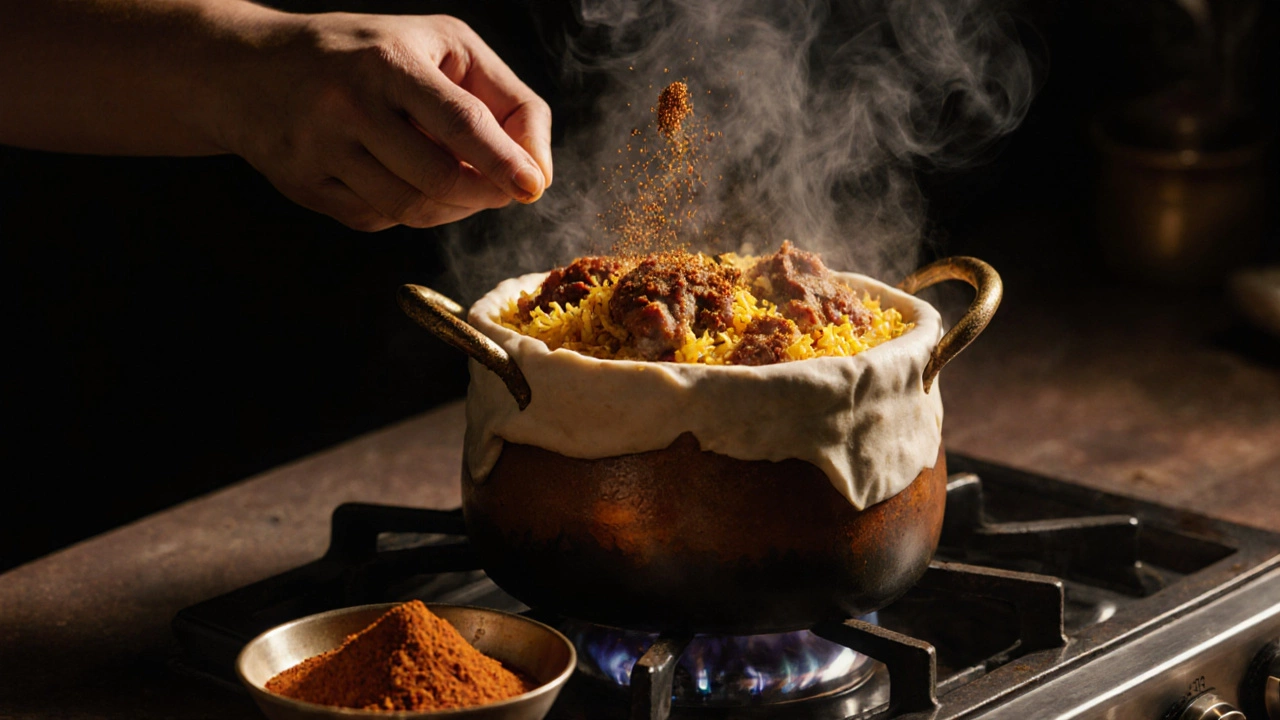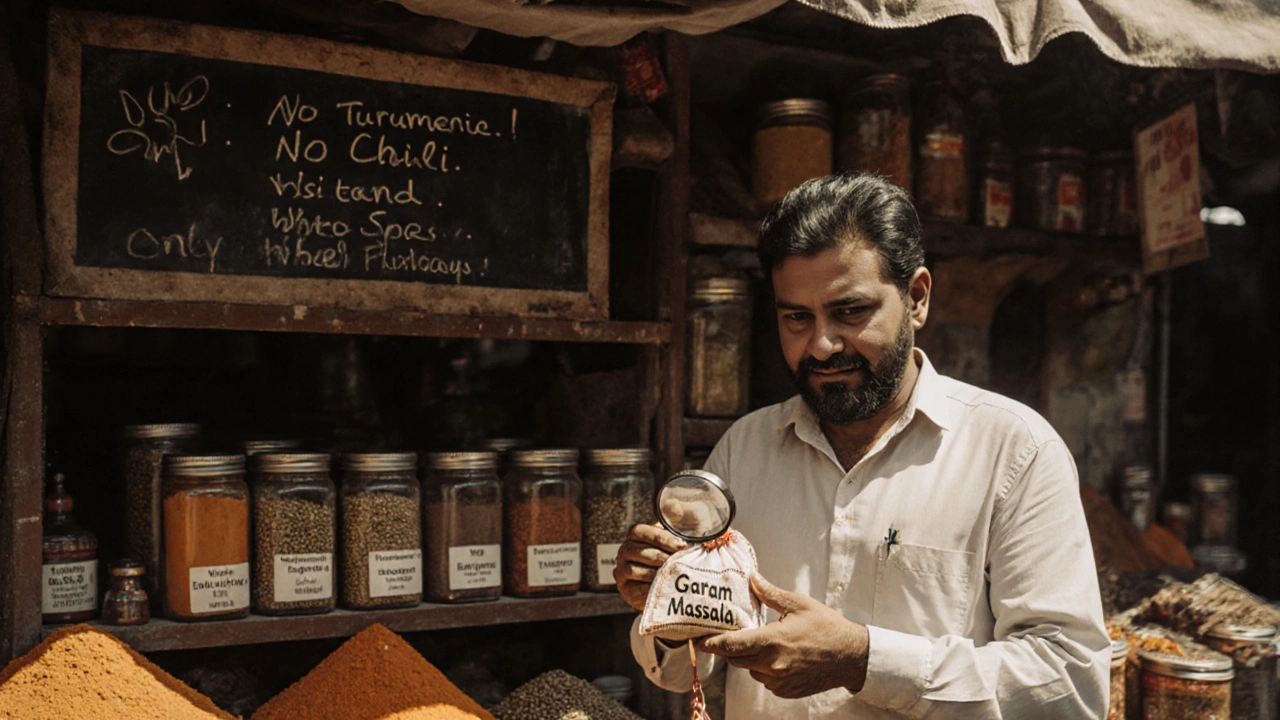Which Spices Are Not Used in Garam Masala? A Clear Guide for Biryani and Curries
 Nov, 20 2025
Nov, 20 2025
Everyone knows garam masala is the heart of Indian curries and biryanis. But if you’ve ever stared at a spice rack wondering what’s not in it, you’re not alone. Even experienced home cooks mix up the list-adding turmeric, chili powder, or even cumin by mistake. The truth? Garam masala isn’t a catch-all spice blend. It’s a carefully balanced finisher, not a base. And knowing what to leave out matters just as much as what you put in.
What Garam Masala Actually Is
Garam masala translates to "hot spice mix," but it’s not about heat-it’s about warmth. It’s a roasted, ground blend meant to be added at the end of cooking, not the start. Think of it like finishing a steak with flaky salt: it wakes up the dish without burning or overpowering.
Traditional garam masala comes from North India and typically includes:
- Cumin seeds
- Coriander seeds
- Cinnamon sticks
- Green cardamom pods
- Black cardamom pods
- Cloves
- Black peppercorns
- Nutmeg (sometimes)
- Mace (sometimes)
These are dry-roasted and ground fresh. That’s it. No turmeric. No chili. No cayenne. No fenugreek. No mustard seeds. Not even ginger powder.
Spices You Think Are in Garam Masala (But Aren’t)
Let’s clear up the biggest myths. These spices show up in your biryani or curry-but they’re not part of garam masala.
Turmeric
Turmeric is the golden base of most Indian dishes. It’s added early, fried in oil to release its earthy flavor. But it’s never in garam masala. Why? Because it’s too strong, too bitter when roasted, and its color would ruin the deep brown hue of a proper garam masala blend. If you see "turmeric garam masala" on a store shelf, it’s a marketing gimmick.
Chili Powder or Cayenne
Heat in Indian cooking comes from dried red chilies, fresh green chilies, or chili powder added separately. Garam masala is about aromatic warmth, not fire. Adding chili powder to it would make it unusable in delicate dishes like korma or biryani, where you want spice without scorching the palate.
Fenugreek Seeds or Leaves
Fenugreek (methi) has a strong, slightly bitter, maple-like flavor. It’s used in small amounts in pickles, dals, or some regional masalas-but never in standard garam masala. Too dominant. Too divisive. It belongs in its own category, not mixed in.
Mustard Seeds
Mustard seeds pop in hot oil to start tempering (tadka) in South Indian dishes. They’re not ground into spice blends like garam masala. Their sharp, pungent bite doesn’t play well with the sweet warmth of cinnamon or cardamom.
Cumin (Whole or Powdered)
Wait-cumin is in garam masala, right? Yes. But only as a roasted seed, not as powder. Many people confuse cumin powder (jeera powder) with the whole seeds used in garam masala. Cumin powder is used for quick flavoring in dals or stir-fries. Whole cumin seeds, lightly toasted, are part of the garam masala blend. Mixing the two leads to uneven flavor.
Ground Ginger or Garlic Powder
These are modern shortcuts. Traditional garam masala uses no powdered roots or alliums. Fresh ginger and garlic are sautéed at the start of cooking. Powdered versions turn bitter when roasted and don’t blend well with the floral notes of cardamom or clove.

Why Getting This Right Matters for Biryani
In biryani, the layering of spices is everything. The base has turmeric, red chili, cumin, coriander powder, and bay leaves. The rice is flavored with saffron and cardamom. The meat is marinated with yogurt, ginger-garlic paste, and whole spices. Then, right before sealing the pot, you sprinkle garam masala on top.
If you’ve added turmeric or chili powder to your garam masala, you’re essentially double-dipping. The dish gets muddy. The aroma loses its clarity. The finish becomes harsh instead of smooth.
Real biryani chefs in Lucknow or Hyderabad don’t add anything extra to their garam masala. They roast their own blend weekly. The difference? One taste and you’ll know.
What to Use Instead
Don’t throw out your turmeric or chili powder. They’re not wrong-they just belong elsewhere.
- Use turmeric with oil at the start of cooking for color and earthiness.
- Add chili powder with the meat or veggies when building the sauce.
- Use fenugreek leaves as a garnish in dals or paneer dishes.
- Toast mustard seeds in oil for South Indian curries or chutneys.
- Use fresh ginger and garlic as a paste in marinades and bases.
Let garam masala do its job: the final whisper of warmth, not the shout.

How to Make Your Own Garam Masala (The Right Way)
Here’s a simple, authentic recipe that works for biryani, curries, or even roasted vegetables:
- Toast 2 tablespoons cumin seeds in a dry pan over medium heat for 2 minutes until fragrant.
- Add 2 tablespoons coriander seeds and toast for another 2 minutes.
- Add 1 cinnamon stick (broken), 10 green cardamom pods (lightly crushed), 4 black cardamom pods, 8 cloves, and 1 teaspoon black peppercorns. Toast for 1 more minute.
- Let cool completely.
- Grind into a fine powder using a spice grinder or mortar and pestle.
- Add 1/4 teaspoon freshly grated nutmeg and 1/8 teaspoon ground mace (optional).
- Store in an airtight jar away from light. Use within 3 months.
That’s it. No sugar. No salt. No turmeric. No chili. Just pure, roasted spice.
Common Mistakes People Make
- Buying pre-made garam masala from the supermarket-most contain fillers like flour or salt.
- Adding it at the beginning of cooking-it loses its aroma.
- Using it as a substitute for curry powder-curry powder has turmeric and fenugreek, garam masala doesn’t.
- Thinking "more is better"-a pinch is enough. Overdoing it makes the dish bitter.
The best garam masala isn’t the one with the most spices. It’s the one with the right ones-and none of the wrong ones.
Is turmeric in garam masala?
No, turmeric is never part of traditional garam masala. It’s added separately at the start of cooking to give color and earthiness. Including it in the blend makes the spice mix muddy and bitter.
Can I use chili powder in garam masala?
No. Chili powder adds heat, but garam masala is about aromatic warmth, not spice. Adding chili powder ruins the balance and makes it unsuitable for delicate dishes like korma or biryani.
Why is my garam masala bitter?
You likely roasted the spices too long or too hot, or you added ground ginger, garlic powder, or fenugreek. These burn easily. Stick to whole seeds and toast gently. Always grind fresh.
Is garam masala the same as curry powder?
No. Curry powder usually contains turmeric, fenugreek, and chili powder-none of which belong in garam masala. Garam masala is roasted, warm, and used at the end. Curry powder is a British invention meant to mimic Indian flavors and is used as a base.
How long does homemade garam masala last?
About 2 to 3 months in an airtight jar, away from light and heat. After that, the volatile oils fade and the flavor becomes flat. Buy small amounts of whole spices and grind fresh every few weeks.
Can I add nutmeg or mace to garam masala?
Yes, but sparingly. Nutmeg and mace are optional and used in small amounts (a pinch each) in some regional versions, especially in North India. They add depth but shouldn’t dominate. If you’re new to making it, skip them until you’re comfortable with the base blend.
